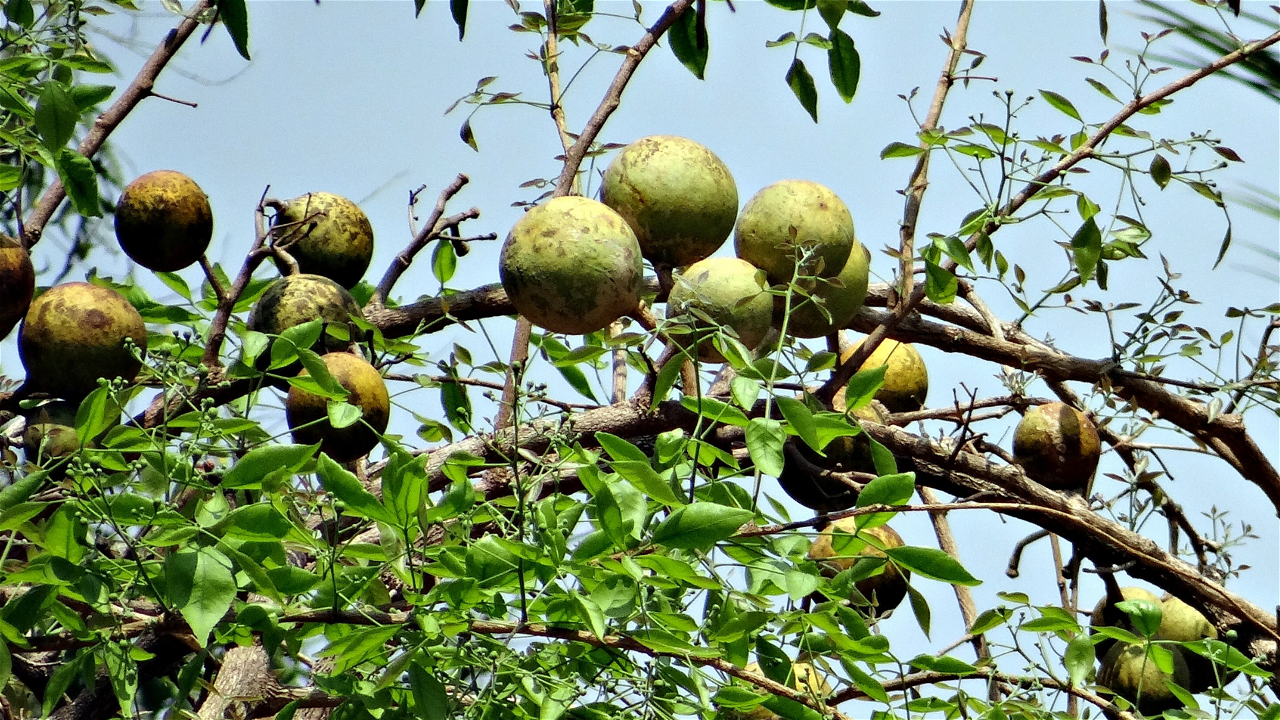
Bael (Aegle marmelos), also known as Bengal quince, is a fruit-bearing tree native to India and other Southeast Asian countries. Rich in nutrients and valued for its medicinal properties, bael is used in various forms such as fresh fruit, dried, powdered, or processed into products like sherbet and candy. Over the years, with the increasing cultivation and demands, agricultural research institutes in India have developed various Bael varieties to enhance yield, improve fruit quality, and cater to specific climatic conditions. Let's explore the diverse Bael varieties developed through meticulous research with their unique characteristics. Read On.
Varieties developed by N. D. University of Agriculture and Technology, Faizabad, Uttar Pradesh
-
Narendra Bael-5 (NB-5): This variety has a semi-spreading growth habit and is known for its precocious and prolific bearing. The fruits are medium-sized, round with a thin rind, and have light yellow pulp that is low in mucilage and seeds. The taste is excellent with a Brix value of 33°, and it is suitable for both fresh consumption and processing.
-
Narendra Bael-7 (NB-7): This variety features large, round fruits with a very thick rind. It is a sparse bearer but highly suitable for processing due to its low mucilage and fiber content. The fruits have an attractive yellow pulp with a Brix value of 30°.
-
Narendra Bael-9 (NB-9): Known for its compact canopy and high yield, NB-9 produces medium to large fruits with a thick rind and golden-yellow pulp. The taste is slightly acidic with a Brix value of 38°, making it ideal for both fresh use and processing.
-
Narendra Bael-16 (NB-16): This erect variety starts fruiting early and produces small, round fruits with a very thick rind. The pulp is excellent in taste with a Brix value of 36°, suitable for powder production.
-
Narendra Bael-17 (NB-17): With an erect and semi-spreading growth habit, NB-17 yields slightly large fruits with thin rind and attractive yellow pulp. The fruits are excellent in taste with a Brix value of 34° and are suitable for both table and processing purposes.
Varieties developed by G. B. Pant University of Agriculture and Technology, Pantnagar, Uttarakhand
-
Pant Aparna: This variety is almost thorn-less with drooping foliage. The fruits are globose with thin rind and sweet, tasty flesh. It is a heavy bearer with good flavor, making it suitable for fresh consumption.
-
Pant Shivani: An early mid-season variety, Pant Shivani produces large, ovoid-oblong fruits with lemon-yellow pulp. The fruits have good storage quality and low mucilage and fiber, with a Brix value of 36°.
-
Pant Sujata: Despite the issue of fruit splitting, this mid-season variety has good flavor and storage life. The fruits are light yellow with a thin rind and low mucilage, making them pleasant to taste with a Brix value of 32°.
-
Pant Urvashi: An early mid-season variety, Pant Urvashi is a heavy bearer with large, yellow fruits and light yellow pulp. The fruits have a Brix value of 33° and are suitable for both fresh consumption and processing.
Varieties developed by ICAR-Central Institute for Sub-tropical Horticulture, Lucknow
-
CISH-B-1: This early maturing variety produces small to medium fruits with high seed content and attractive yellow pulp. The fruits have a Brix value of 34° in pulp and 43° in mucilage.
-
CISH-B-2: This variety yields medium-sized fruits with thick rind and light yellow pulp. The fruits have a Brix value of 31° and are good for processing due to their thick rind and low mucilage.
Varieties developed by Central Horticultural Experiment Station, Vejalpur, Gujarat
-
Goma Yashi: This variety is highly suitable for making sherbet, squash, candy, and murabba. It has high-quality attributes like papery shell, minimal fiber and mucilage, and attractive pulp color with pleasant aroma.
-
Thar Divya: This early maturing variety is less affected by sunscald and produces medium-sized fruits with a Brix value of 35° to 39°. It is highly suitable for rainfed semi-arid ecosystems.
-
Thar Neelkanth: With compact growth and medium height, Thar Neelkanth is ideal for dry land conditions. It produces quality fruits with pleasant flavor and aroma, suitable for various processed products.
Varieties developed by ICAR-Central Institute for Sub-tropical Horticulture, Lucknow, Uttar Pradesh
-
CHESB-11: Known for its high yield and good flavor, CHESB-11 produces medium-sized fruits with a Brix value of 38° in pulp and 50° in mucilage. It is rich in antioxidants and suitable for sherbet, murabba, and powder making.
-
CHESB-16: This late maturing variety has a drooping growth habit and produces fruits with high antioxidant activity. The fruits are excellent for making RTS (ready-to-serve) drinks, candy, and murabba.
-
CHESB-21: With a high yield and good flavor, CHESB-21 produces large fruits with a Brix value of 39° in pulp. It is highly suitable for pickle, sherbet, candy, jam, and powder making.
















